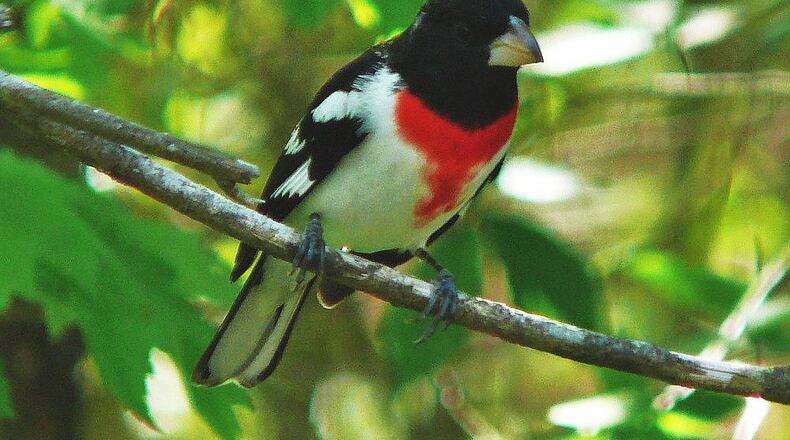I always get this question — or a variation of it — from at least a few folks about this time of year: “A strikingly beautiful bird is coming to my feeder. It has a big red spot on its white breast, one of the prettiest birds I’ve ever seen. I’d never seen it before now. What is it?”
There’s no doubt about the answer: The bird is a male rose-breasted grosbeak. Decked out in his spiffy black and white breeding plumage, he is indeed gorgeous. But making him absolutely dazzling now is a vibrant rose-pink triangle emblazoned on his radiant white breast.
For many people, seeing a male rose-breasted grosbeak for the first time can be an unforgettable experience. Even veteran birders gasp in surprise when they spy the male. The female’s coloration is much drabber, mostly a streaky brown.
Rose-breasted grosbeaks are migrating through Georgia now on their way to nesting grounds farther north — although a few might nest in the highest elevations of the state’s northeast mountains. But as they travel across the state, they may show up at feeders that offer black oil sunflower seeds and similar morsels. And they might stick around for a few days before traveling on.
Two other migratory, “eye candy” birds that might appear at feeders during the next few weeks are the blue grosbeak and the indigo bunting.
The male blue grosbeak, a cousin of the rose-breasted grosbeak, sports deep, cobalt blue plumage, a tiny black face mask, chestnut-brown wingbars and a black-and-silver beak that make him one of Georgia’s most colorful birds. He and his cinnamon-colored female mate may be attracted to grains and seeds at feeders in yards with shrubs.
The stunning male indigo bunting is a dazzling, electric blue. One of the most breathtaking sights I have ever seen in my DeKalb County yard was a vivid male blue bunting next to some neon-bright yellow male American goldfinches at a feeder. Both male and brownish-colored female indigo buntings may show up at feeders offering hulled sunflower seeds and small seeds.
IN THE SKY: From David Dundee, Tellus Science Museum astronomer: The moon will be full April 12 — the Flower Moon, as the Cherokee people called this month’s full moon. Mercury, Venus and Saturn are low in the east just before sunrise. Mars (high) and Jupiter are in the west just after dark.
Charles Seabrook can be reached at charles.seabrook@yahoo.com.
About the Author
Keep Reading
The Latest
Featured



